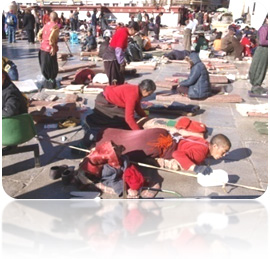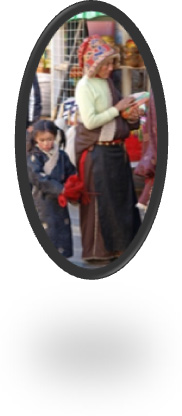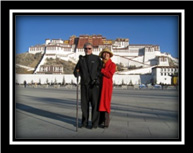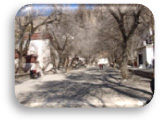CHINA - CHENGDU (1-09-09) and TIBET (1-10/11-09)We had a short (2 ½ hr.) flight from Siem Reap (the airport nearest Angkor Wat) to Chengdu, China, a bustling and economically thriving southwest China city. When we landed in China, part of the group split off to take a commercial flight to Xian. Xian is where the buried terra cotta soldiers were found, and more are being excavated all the time. We were in Xian a couple of years ago and so decided to join the group flying to Llasa, Tibet the next day. Since we had the afternoon in China to ourselves, we chose to go to the hotel and then exercise our "airplane legs" by taking a walk around the city rather than visit a panda zoo out in the country which involved 45 minutes of driving each way (those who went to the zoo said we made the right choice). The area around our hotel was quite cosmopolitan but the store merchandise we looked at during our walk (made in China, of course) somehow seemed slightly substandard. How is that possible since these were not knockoffs? One of the most interesting things we saw on our walk was a very creative use of space under a major freeway interchange. One such area was landscaped with small trees and shrubs, outfitted with simple chairs and tables (probably for playing chess), and offered a simple but extensive range of outdoor gym equipment. There were a number of people using the gym equipment. We had an excellent dinner in the hotel's very popular Chinese restaurant and then got our things packed for an extremely early departure the next morning to Tibet. TIBETIn spite of the fact that almost everyone going to Tibet took altitude After seeing the Temple, which was extraordinarily colorful, we walked around the Temple block (along with a few thousand Tibetans who circumnavigate the temple as a kind of walking prayer). Along this route also were dozens and dozens of colorful stalls selling everything from brightly colored fabrics to totally fake "turquoise" and "coral." Walking around religious shrines was not just confined to this temple (a complete circle would take no more than 30 minutes) but is part of religious observance at the Potola Palace itself, where a walk around the Palace (and more particularly the small mountain on which it is built) takes 3+ hours. There is also an affinity for odd numbers, so apparently walking around the Palace three times is the order of the day. While the Chinese New Year is in January, the Tibetan New Year follows it by about a month. This is a fascinating time to be in Llasa because many pilgrims from the countryside come to Llasa for about a month, both to worship and to buy goods in preparation for the upcoming planting season. This meant that there were an unusually large number of people in traditional dress. They had hard working, happy faces, and were as openly curious about us as we were about them. In one particularly touching exchange, a tiny woman walking with a cane came up behind Peter and, with her cane, tapped on his combo tripod/walking stave. When Peter stopped and put the tripod on the ground, this small woman measured her small cane against the tripod, looked up at Peter and laughed, and then without further ado, ambled on.
Our last stop was the summer palace of the Dalai Lama, the location from which the current Dalai Lama fled. It is full of different types of trees and must be really gorgeous in the summer, but this garden spot did not have much to offer in the winter with the exception of a lovely walkway lined on one side with pines and on the other side by graceful, overhanging bamboo. The interior of the Dalai Lama's residence looked much like the temples we'd seen because of all the Buddhist paintings, statues, etc. in it, but as a comfortable living space it seemed primitive and sparse (at least from a western perspective). |
 medicine, moving around meant moving s---lo-oooow. We were told that 3 bright and sunny days were in store for us, but that it was going to be cold. We drove about 40 miles from the airport to Llasa through winter-dry mountainous terrain. The City is spread out American style, although highrises are severely limited (good idea). Our first stop of the afternoon was a temple that is considered the birthplace of Buddhism in Tibet. Among the more interesting things we observed is the style of worship. The
medicine, moving around meant moving s---lo-oooow. We were told that 3 bright and sunny days were in store for us, but that it was going to be cold. We drove about 40 miles from the airport to Llasa through winter-dry mountainous terrain. The City is spread out American style, although highrises are severely limited (good idea). Our first stop of the afternoon was a temple that is considered the birthplace of Buddhism in Tibet. Among the more interesting things we observed is the style of worship. The  people go from a standing, to a kneeling, to a totally prostrate position facing toward the temple. The palms of their hands are covered by one-sided pad-like mittens. This helps them worshipers slide from a kneeling to fully prostrate position onto their waiting blanket or skinny mattress. They do this repetitively, possibly for hours at a time. Prayer wheels and prayer flags added to the uniqueness of the worship style; these pilgrims are utterly single-minded and devout.
people go from a standing, to a kneeling, to a totally prostrate position facing toward the temple. The palms of their hands are covered by one-sided pad-like mittens. This helps them worshipers slide from a kneeling to fully prostrate position onto their waiting blanket or skinny mattress. They do this repetitively, possibly for hours at a time. Prayer wheels and prayer flags added to the uniqueness of the worship style; these pilgrims are utterly single-minded and devout.  The next morning we decided to skip climbing the thirteen stories up (and down) the outside of the Potala Palace in the freezing cold (and "freezing cold" was without the wind chill taken into account) in favor of a trip to the Poralepu monastery. That monastery is located across the square from the Potala Palace. This small monastery (much smaller than the one we saw yesterday) was fascinating because part of it was carved into solid rock. As an added benefit, we still got to see the magnificent views of the Potala Palace from a point further away and on top of a small hill. This picture of us, however, is on the square in front of the Palace, not at the monastery.
The next morning we decided to skip climbing the thirteen stories up (and down) the outside of the Potala Palace in the freezing cold (and "freezing cold" was without the wind chill taken into account) in favor of a trip to the Poralepu monastery. That monastery is located across the square from the Potala Palace. This small monastery (much smaller than the one we saw yesterday) was fascinating because part of it was carved into solid rock. As an added benefit, we still got to see the magnificent views of the Potala Palace from a point further away and on top of a small hill. This picture of us, however, is on the square in front of the Palace, not at the monastery.  In the afternoon we went to the second largest monastery in Tibet, called the Sera,founded by an order of monks called the "Yellow Hats." It was actually a small city with homes for hundreds of monks. The day we visited (January 11) was a holy day for the Buddhist worshipers. They were taking their children to be "protected" by the monks. Protection consisted of a black smudge on the child's nose. There were huge prayer wheels at several locations which the worshipers could spin as they walked by.
In the afternoon we went to the second largest monastery in Tibet, called the Sera,founded by an order of monks called the "Yellow Hats." It was actually a small city with homes for hundreds of monks. The day we visited (January 11) was a holy day for the Buddhist worshipers. They were taking their children to be "protected" by the monks. Protection consisted of a black smudge on the child's nose. There were huge prayer wheels at several locations which the worshipers could spin as they walked by.